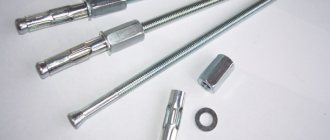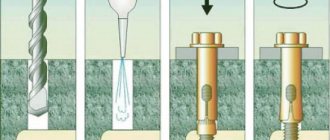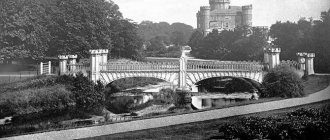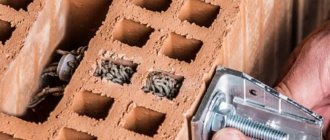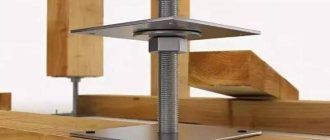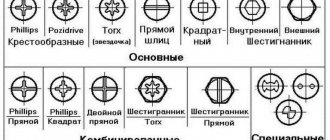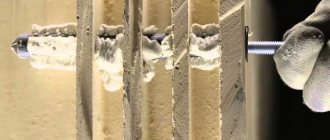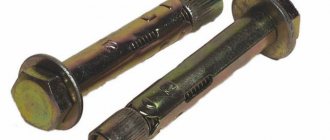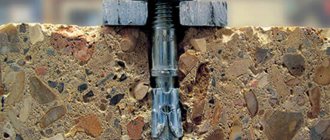Modern building materials are actively improving their performance qualities. Manufacturers provide new products with a wider range of protective properties, and also improve basic technical indicators. Fasteners are not lagging behind in this regard, in the development of which structural design plays a significant role. An example of a successful fixing device is a frame dowel, which combines both reliability and versatility of use. However, the special design of this hardware still limits the range of areas of its use.
General information about frame dowels
At its core, this hardware has a rod, which in principle resembles an ordinary screw or self-tapping screw. Its task is to tighten and fix two or more structural components. But the main difference is the presence of an auxiliary element that holds the anchor. A frame dowel usually does not require the use of special industrial tools for installation. Most often, even specialists limit themselves to a basic set of tools that allow them to form a hole of suitable size.
Dowel design
The design of this type of dowel is complicated in different parts. This includes the spacer part, which comes separately, the head, and the screw area itself. As for the wedging section, the metal frame dowel interacts with it in such a way that the risk of twisting is prevented during operation. In addition, this unique attachment also protects the wall niche from unnecessary mechanical damage, providing a delicate but at the same time rigid fit.
As for the head, there are different options for its design, among which two stand out - a flat “eternal” and an enlarged cap. The first modification, as the name suggests, does not involve dismantling, so it can be masked with a layer of plaster. The flattened and smooth head practically does not protrude onto the surface of the structure. The frame dowel is designed differently, in which an enlarged head is implemented. These types of hardware are designed taking into account the possibility of unscrewing without the risk of mechanical damage or tearing of the head. The working part of the screw, in fact, resembles traditional hardware such as screw cutters, but in this case considerable emphasis is placed on the formation of a protective coating - for example, through galvanizing.
Dowel anchor as a key structural element
It will not be superfluous to know how this fastening technology works, which elements perform the main tasks in the operation of this mounting element. All the same technical characteristics warn us that this design is intended for light loads due to its weak holding properties. Therefore, fasteners may not be able to withstand objects that are too heavy; be aware that one such anchor can withstand a load of up to 30 kilograms.
The design of our fasteners includes a metal sleeve, which, using the expansion method, jams the fastener in the wall or floor; thanks to the ribs on the sleeve, it is not able to rotate during installation, thereby ensuring high-quality adhesion in the hole. The sleeve is pushed apart by a cone-shaped nut, which is screwed onto the base.
Also, for convenient installation, the stud has a head with slots for a shaped screwdriver. According to the installation rules, the cap must be hidden in the material and not stick out; for this, it is also made in the form of a cone and easily fits into a pre-prepared “slot”. Typically, all fasteners of this design are mounted with a wide cross-shaped screwdriver, which greatly facilitates installation in hard-to-reach places.
Element dimensions
Dowels are supplied in different sizes, which allows you to fasten materials with an average total thickness of 40 to 170 mm. The length of the screws can be from 70 to 220 mm, while the functional part of the hardware is calculated to be 5-15 mm shorter. In terms of diameter, the range of sizes is much more modest and varies on average from 8 to 10 mm. From the point of view of durability and strength properties, it is important to take into account the technical parameters of the protective layer that covers the frame dowels. The thickness of a galvanized coating, for example, can range from 5 to 10 microns. This value, almost invisible to the eye, nevertheless provides a noticeable protective effect for the metal during operation.
How to properly install the fastening element - step-by-step diagram
Step 1: Install the frame into the opening using spacers
Before you start drilling holes and permanently securing the window block, the frame itself must be correctly positioned on spacers, align the window block relative to the vertical plane and, accordingly, the horizontal one. To do this, we use pads under the frame and wedge the frame on both sides with wedges. We hammer the wedges in as tightly as possible so that the frame stands firmly in the window opening. The building level will help us check the evenness. If deviations are observed, then with light blows of a hammer we remove these defects, moving the frame in the desired direction.
Step 2: Mark the attachment points, make a “hidden”
Now that we have firmly fixed the frame, we need to mark the places where our mounting bolts will be located. Usually four fasteners are enough for a small kitchen window, but if you have to deal with a wide window opening, the number of fasteners can be increased. According to the standard, the installation location of the dowels is 30 centimeters from the upper and lower corners of the window block. If this standard does not suit you, you can change it. Regarding the “sweating”, some window frames already have it, but if you do not have such a recess, make it yourself by drilling a hole to the height of the dowel head.
Step 3: Mounting the Fastener
Then everything is simple, if you have a wooden frame, then with the drill that we have prepared, we drill through the frame, while going deep into the concrete to the required distance. Then we insert our bolts around the entire perimeter into the finished holes and tighten them with a Phillips screwdriver. The fastener will be released from both sides into the concrete and window frame, on one side by a cone-shaped nut, on the other by a cap. After all the bolts are tightened, seal the cracks around the perimeter of the window with foam, and the installation of the window unit is complete.
Material of manufacture
The main screw is most often made of steel. This is a reliable, rigid and at the same time durable material, optimally suited to the requirements of fastening operations. Its only weak point is its susceptibility to corrosive processes, but technologists, as already noted, provide galvanized and other galvanic coatings that protect hardware from destruction. It is also worth paying attention to the material of the spacer tip that is supplied with the frame dowel. A nylon element can be considered as the optimal solution, although there are also quite hard plastic analogues. Moreover, dowel bases are often made from synthetic plastic materials. Such hardware in its design is quite consistent with the group of frame models, with the exception of the material of manufacture. Such products are used for highly specialized purposes, for example, in the construction of thermal insulation panels that do not require rigid and high-strength fixation.
Varieties
First of all, it is worth pointing out the similarity between frame dowel models and façade dowels. They have a similar structure, but there are differences in characteristics that determine the scope of application of the elements. Thus, standard frame hardware is designed for servicing wooden, plastic and various composite materials, the load of which does not exceed 30 kg. In turn, the facade dowel is distinguished by the ability to work with external cladding. These are panels that perform the tasks of thermal insulation, decoration and certain protective functions. Within their classes, both frame and façade products differ according to the same characteristics - slot parameters, faceting of the heads, operating principle of the spacers, etc.
Peculiarities
The main difference between a frame anchor and any other anchor-type fastener is an elongated pin with a countersunk conical head. All this is necessary so that the three-dimensional structure of a window frame or door frame can be secured to a usually solid wall material. The fasteners are excellent for installing hollow structures, such as modern metal-plastic window frames or metal door jambs.
The purpose of fastening is to securely fix the frame in the opening. Since such structures, in addition to constant load, constantly experience variable dynamic influences (arising from their functionality), special requirements are imposed on the fasteners intended for their installation. It must be resistant to tearing and bending, while being tolerant of vibrations.
A metal anchor bolt and a spacer sleeve make it possible to combine all the requirements for such fasteners, which has significantly expanded the scope of application of frame anchors. Currently, they are purchased not only for installing a window or door, but also for installing various types of structures, decor, or hanging not very heavy equipment.
The appearance of frame anchors has caused the need for their standardization; as a rule, they comply with specifications, since during the development of GOSTs such fasteners did not exist at all. But the alloy (steel, stainless steel, brass, aluminum) used for their manufacture must strictly comply with GOST, which standardizes the products of metallurgical enterprises.
Purpose
Frame-type hardware is more likely focused not on power loads, but on the implementation of the most advantageous structural fastening schemes. For this reason, they are often used in the installation of window and door openings, in the production of furniture and in the fastening of finishing materials. From an operational point of view, a frame dowel is advantageous in that it causes minor mechanical damage to the base into which it is integrated. But this also causes restrictions of another kind. In particular, frame fasteners are not suitable for rigid fixation of massive and heavy structures. Some manufacturers even set restrictions on the use of dowels when working with certain materials - usually metal. On the other hand, to ensure rigid fastenings, you can replace the frame model with a facade model designed for heavy loads.
Anchor - classification and scope of use
According to unconfirmed statistics, it is believed that Russia is capable of absorbing about 15 thousand tons of all kinds of anchors in one quarter, which is only three months. Our mounting element is almost at the top of this list. This is explained simply: this type of fastener is made so popular by its technical characteristics and a fairly wide range of applications.
But initially, such fasteners were intended for attaching window frames and door frames to a concrete and brick base. It is thanks to its purpose that such a dowel received the “frame” classification. Today, fasteners correspond to their immediate technical characteristics, and most of this type of dowels is used for installing metal-plastic windows and door frames made of various materials.
But thanks to its versatility, the use of the anchor did not end with the above tasks. As it turned out, such fasteners were ideal for mounting wooden beams and slats to various bases. For example, it is very convenient to use such an anchor when installing a wooden beam when installing a floor on a small area; in practice, it could be an ordinary balcony block, the floors of which you want to make of wood.
How to choose a frame dowel?
Unlike standard screws and standard dowels, this fastener requires a special calculation to match a specific standard size to the installation tasks. Each parameter matters. For example, in harsh operating conditions, a thick protective coating must be provided on the outside. If you plan to install while maintaining a smooth surface, then you should choose a metal frame dowel with a flat head. And, of course, it is mandatory to select an element in terms of dimensional parameters - the characteristics of length and width that are suitable for the format of the target building material are assessed.
Installation recommendations
First of all, before attaching the dowel, the working surface is cleaned. Next, you need to choose the method in which the hole will be implemented. Typically, electric screwdrivers with suitable attachments are used for such needs. In this part, you should evaluate not the diameter of a particular screw, but the size of its spacer nozzle, which will hold the rod in the niche being created. Also, depending on the operational requirements, it may be necessary to hide the cap. To do this, a chamfer is additionally formed, expanding the outlet part of the hole to integrate the head. By the way, if you are installing a frame dowel for hollow materials, then you can get by with a hand tool, which will delicately and with greater precision allow you to prepare the hole for the hardware. Next, the spacer is installed, followed by tightening the fastener.
Rules for mounting the fastening element
Let's now look at the basic rules for installing our dowel using a specific example. After all, compliance with all technical conditions for installing the anchor determines how the structural element we have secured in the future will hold, be it a door frame or a wooden beam on which we are going to hang a heavy carpet. First of all, we need to prepare the tool with which we will carry out the installation.
To do this, we will take a hammer drill, a drill for it, with a diameter of 8 millimeters, and we will also need a Phillips screwdriver to tighten the fastening pin, and also prepare a hammer, we cannot do without it. As an example, we will look at installing a window frame and then using our frame fasteners. So, let’s get started and go through all the steps of installing a window unit step by step.


